


Trained Retrieve, Balanced Training Method
A Step by Step Technique
Mac, Trained to the MH level at Cinnstar
Preface
I have said for years that I was not going to write an article on how to teach the trained retrieve. There are many reasons for this. Most importantly is that there are so many problems you can run into teaching a trained retrieve. It is impossible to list every answer to every problem or training scenario. Retrievers are individuals and to be able to suggest an answer to most problems you really need to see what is going on first hand with the retriever, prior to making a suggestion on how to correct the problem. Sometimes there might be more than one answer. And the answer is dependant on the retriever’s individual temperament. One size does not fit all.
Presented on this web page is some introductory philosophy and overview of methods that are important to understand. The actual Trained Retrieve article (12 pages) and the seven slide shows are downloadable in pdf format at the bottom of this page. Or you can skip reading this introductory web page if you like and go directly to the Trained Retrieve article. The article itself has even more detailed information on training philosophy along with the step by step process of teaching the trained retrieve. And you can print out the pdf article and slide shows for easy reading and reference.
We at Cinnstar feel very strongly about not working from this article in a vacuum, alone. Please work with someone who has success with his or her own retrievers, or a professional who you have confidence in. I am also available to help. If you have any questions or are having problems, please Email, or call me. I will do everything I can do to help. I want you to succeed.
I strongly suggest that prior to using this article that you take a bit of time and also read several other articles I have written. They give a good idea of my training philosophy and will help you understand the methodology of this article. These articles are: 1. Balanced Training, Theory and Methods, 2. Never Say Never, Never Say Always, 3. Developing a Good Training Attitude. 4. Pressure and it Effects on the Retriever. These are available on the website.
This method of trained retrieve utilizes the Balanced Method of Training. Praise, Encouragement, Teaching, and Consequences (correction) are used together in combination. The terminology "force fetch" conjures up all kinds of horrors to some. As you read thru this article you will see that this is not what this article is all about. Thus I use the term force fetch and trained retrieve interchangeably. It is a Force Fetch method as force (ear pinch/twist) is used. However, Praise, Encouragement, and Teaching are used to motivate and train the behavior. It is completely different then the harsh methods used by some trainers. The Balanced Method of Training is suitable for almost all dogs, not just retrievers. It is a flexible program, using the dog's temperament as a key to what best motivates and achieves the results the trainer desires from the dog.
This article does not explain all the reasons of why or the philosophy of force fetching the retriever. That is detailed in a companion article. I have attempted this “how to” article first as it is what so many people request. They already know that they want to or have to force fetch their retriever; they just want a procedure on how to accomplish the task.
Any kind of trained retrieve will not make a retriever that lacks good basic retrieving instincts into something it is not. A trained retrieve supplements the retriever’s natural desire. It prevents problems as much as cures current problems. A trained retrieve for obedience, where the dog only has to go out at a fast trot 30 feet and retrieve a dumbbell can be taught in time, to most dogs. Retrieving in the hunting, hunt test or field trial environment is different. It requires a lot of natural talent. All retrievers have a given amount of natural talent. It is difficult for the novice trainer to understand or accept if they discover that their retriever does not have the talent to reach the level they desire. Not every retriever has the talent to become a Master Hunter (MH) or Field Trial competitor, or even a Junior Hunter (JH). You need to make the best of what you have, or find another retriever that has the talent level you desire. I should mention that there are a few retrievers that should not be taught the trained retrieve, such as those who are extremely shy, or that hold such resentment, or are not birdy enough to help overcome resentment. These thankfully are few and far between.
This method, with only a few changes is very similar to the one I was taught in Los Angeles in my Open obedience class in 1968. I learned it with my Shelties. Giving credit where credit is due my instructor was Shirley Indelicato who has Miniature Poodles and is an AKC licensed obedience judge. If this method will not hurt (physically or mentally) a delicate Sheltie or Poodle, it will certainly not hurt your retriever. The only difference in my current method is: 1) the use of a table; 2) a day or two of introductory acceptance of the dumbbell by opening the retriever’s mouth and placing the dumbbell in, and teaching “hold” before force is ever applied; 3) stressing “Hold” more than is taught for obedience; 4) the last phase of learning to correctly retrieve a bumper and then a bird; and 5) retrievers are taught to go directly to heel, ready for the next retrieve. They do not sit in front of the handler. My retrievers hold obedience titles and field titles. Retrievers learn when the retrieve requires delivery in front, or delivery at heel. I teach the delivery to heel first as the field is my primary venue, but one could do this differently.


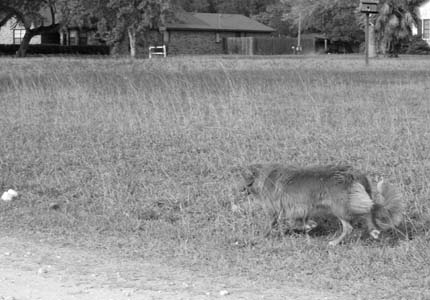
This article only teaches the basic ear pinch Trained Retrieve (force fetch). It does not go into the force to a pile, collar (e collar) conditioning, and collar force fetch. While all my retrievers are forced to a pile and collar conditioned as part of their basics program, it is something the novice does not want to attempt on their own. You need to work with a professional or amateur that knows how to do this. There are some retrievers that cannot take this amount of pressure, and it is a very delicate line, so that you have to really know what you are doing.
Most professionals today, who care about the retrievers they train, use a method similar to this one. It is far from the “Hell Week” of old. Most of the time the procedure is fairly gentle. Pressure is just one component in the Balanced Training Method. Pressure or Correction is not anymore or less important then the use of: Teaching, Praise, and Encouragement. All four must be used in harmony. That is why the Balanced Method is suitable for most dogs. You adjust the amount of each component: Praise, Encouragement, Teaching, and Correction to suit each dog’s temperament. Know your dog, each one is an individual.
Amount of TimeThis method takes about six to eight weeks to complete using a table. Time to teach is faster or slower depending on the retriever’s temperament and trainability. Each day, the time it takes is not a lot. Do not “grind” on the retriever. Each retriever will have a maximum time they can or will concentrate. This ability to concentrate will increase as the retriever gets older AND with gradually extending the training time. Concentration and focus is in-born to a large extent. A good trainer will continue to develop this trait. Watch for tell tale signs of tiring (mentally) and heed them. On the same token, do not let your retriever “con” you. Take short breaks to pet and let the retriever relax. This is a great stress reliever.
You should work the retriever almost every day until the trained retrieve is complete. Yes, sometimes a day or so break is good for you and your retriever, but do not drag this on and on. You want to get it accomplished as expediently as possible without overwhelming your retriever. Taking longer then necessary causes more resentment.
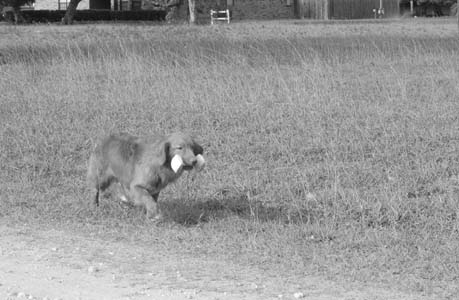
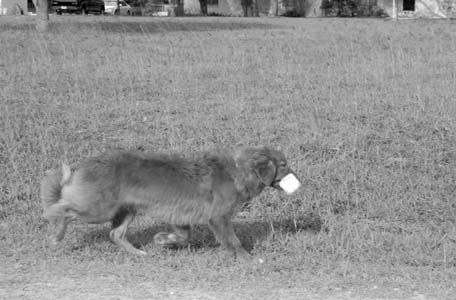
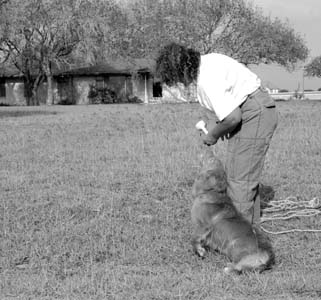
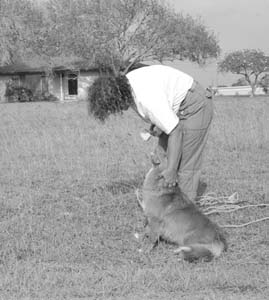
Age to Teach the Trained RetrieveTo me, the trained retrieve is a beginning, not an ending. Without a trained retrieve of some kind, you cannot progress to any higher level of training in the field. You cannot teach complex marking skills, or handling if you are worried about the whether the retriever will bring the bird (or bumper) back all the way.
I like to teach my retrievers the trained retrieve as soon as they have lost all of their puppy teeth, anywhere from about five and a half months to six months of age on up. Much prior to that their mouths are sore from lack of teeth, and they are not really mentally mature enough or have the attention span. For a retriever that is not going to be shown in conformation, I like to get the pup thinking obedience first. I like them heeling and almost automatically sitting every time before I start to teach the trained retrieve. I also like them doing a sit stay at the end of the leash for a very short time. As we progress I continue their obedience training as well. Because my emphasis is field training over obedience trials, I do not teach the entire Novice Obedience routine at this time, but one could.
I have also used this method on many older retrievers. Most of the time it is more difficult, but not necessarily. Trainability, independence and level in the pack (is the dog or bitch the alpha?) will play an even greater role in an older retriever. Plus you have more bad habits, many of them deep-seated to overcome. For retrievers being shown in conformation, I have found if they are not thoroughly show trained before starting obedience training, they will tend to sit in the conformation ring. So I delay the obedience. They learn to sit, and go to heel, ect on the table. I do not practice heeling in the yard. But really, the important point to remember be it conformation training or obedience, the retriever must be under control, and mentally mature enough to learn a complex task such as the trained retrieve. The retriever must have “learned how to learn”.
Field Work While Teaching the Trained RetrieveDepending on the retriever, many times you can continue training in the field while you are force fetching your retriever. Just accept the delivery of the bird or bumper that they give you. Sometimes this is not possible. Bad habits may have already surfaced. They may run away with the bird, play around with it, or run out to it and refuse to pick it up. If this happens, it is just better to not train the retriever in the field until the force fetch is completed. Further if the retriever is able to associate the force fetch with retrieving in the field too early, they will most likely stop retrieving, or retrieving correctly. With my dogs (clients or my personal retrievers), I like to do what I can, even if it just a hand thrown bumper into the water. Not only does the retriever need the exercise, it needs to release all that pent up energy! Remember, the longer you take to complete a trained retrieve, the more problems you may have to overcome. This is one of the big problems with either a “shaped” or “positive” retrieve: the time factor. In obedience training, this is not a real issue. If it takes 6 months or longer to teach a shaped or positive retrieve and if this is the method you wish to use you can. You just delay going into the Open ring. Open obedience has so many other exercises you have to teach, (and you can teach many of the Utility exercises) that generally this is not a concern. But in retriever training in the 6 months or more you are teaching a shaped retrieve so many bad habits can be developed out in the field in this length of time that you will have to fix. If you can! There is no real comparison or analogy in obedience training. A solution might be to not train in the field, or only do retrieves that the retriever shows no development of bad habits like I do. The 6-8 weeks it takes with the method presented here will feel like forever, I would not want to imagine what 6 months would feel like. Especially to a young retriever with all that pent up energy to retrieve. You are missing a critical stage in the young retriever’s development. Another issue is that for any advanced work you have to have a trained retrieve of some kind. This will be put on hold until later.
Final ThoughtsTrained Retrieve procedures are very detailed and at times tedious. You make very slow progress, very small steps at a time. It is very detailed orientated. This is also why it is very difficult to teach the force fetch by writing an article. A trained retrieve is not a single action or process, it is a chain of many, many smaller ones. Each one has to be taught and understood before progressing.
This article is long and detailed. I would read the whole article first, several times, reviewing the slide shows and then start teaching your retriever. This gives you an idea where each part fits in with the whole. In the current obedience vernacular, we back chain the retrieve from the hold. The saying “Make Haste Slowly” cannot be over emphasized. Teach each step before going on to the next. Don’t skip or rush. Each step is built on the previous. During the force fetch, there is a period of resentment by the retriever, and resistance to do what you command them to. This is a phase, which must be gone through, and overcome. The ear pinch/twist MUST be used in conjunction with lots of Praise, Encouragement and Teaching the retriever what you want them to do. It is your job as a good trainer to work with what you have in respects to the retriever’s temperament and trainability. Some retrievers need lots of love and playing before, in between or after lessons. Praise is an integral part in the process!
By utilizing the Balanced Method of Training, your retriever can learn the Trained Retrieve and continue to develop into the energetic, happy, well trained retriever you want them to be. Good Retrieving.Laura G White August 2006
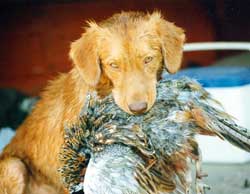
 HR Fox WCXSlide ShowsImportant Note! These Slide Shows are in pdf, they may take some time to download if you have dial up. I would be happy to email them if you prefer. Thanks LGW.
HR Fox WCXSlide ShowsImportant Note! These Slide Shows are in pdf, they may take some time to download if you have dial up. I would be happy to email them if you prefer. Thanks LGW.




Cinnstar Retrievers Laura and Don White 903.335.3806 info1 at cinnstar dot com
This site designed and maintained by Laura White